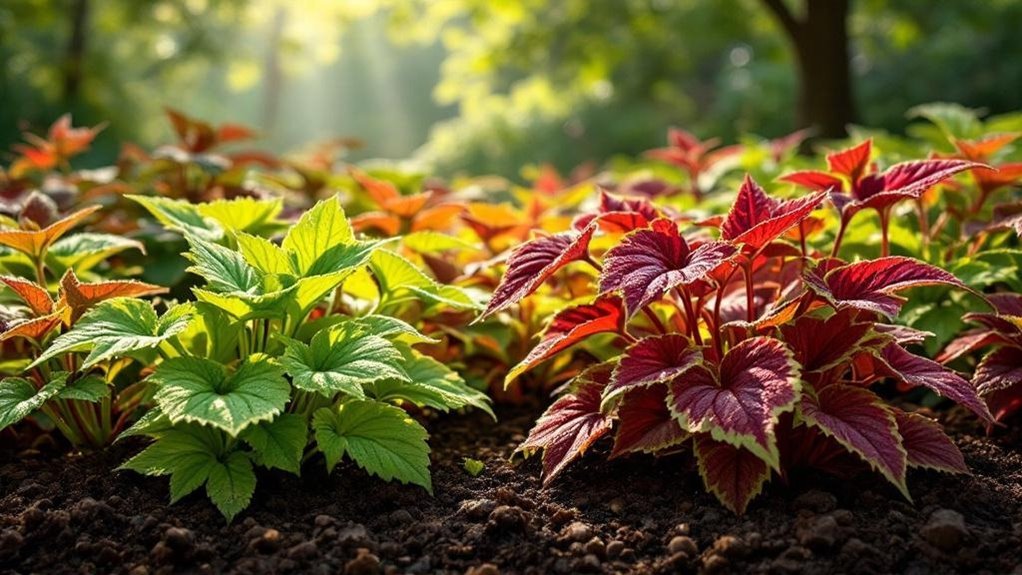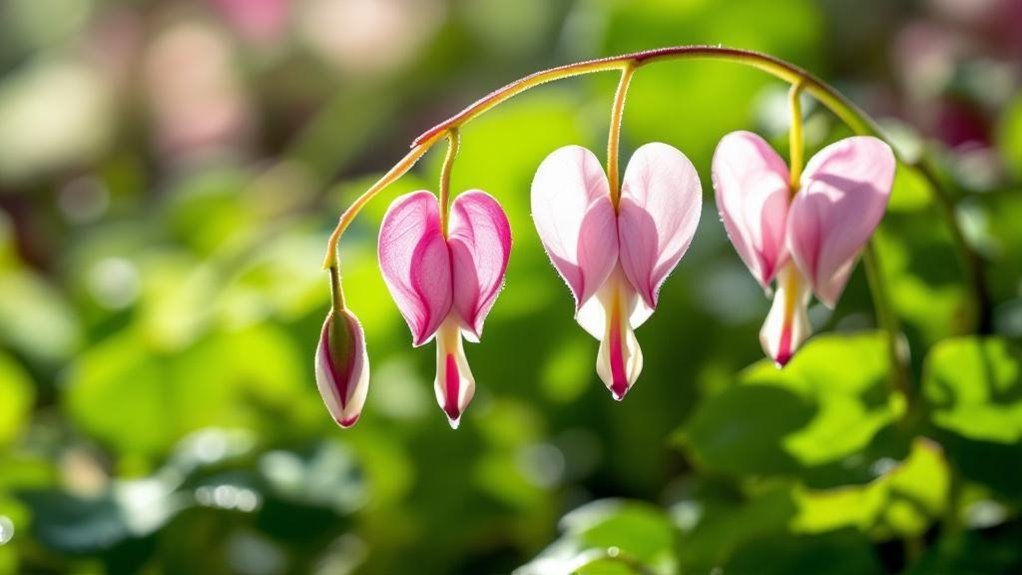Like a painter choosing the perfect shade to complete a canvas, you can transform those tricky, shadowed garden spots with the right flowers. It’s not just about filling space; it’s about bringing life where sunlight barely reaches. Some plants not only survive but truly shine in the shade, offering color and texture you might not expect. Discovering these can change how you approach your garden forever.
SunPatiens
Although many impatiens struggle in harsh conditions, SunPatiens thrive in both sun and shade, making them a versatile choice for your garden.
These shade-loving plants bring vibrant color to difficult garden spots, blooming continuously from spring until the first frost. You’ll appreciate their variegated leaves, which add texture and interest alongside their bright flowers.
SunPatiens are well-suited for partial to full shade and tolerate varying moisture levels, so they’re perfect if you’ve got tricky areas to fill. They typically reach a height of 12 to 24 inches, spreading wide enough for borders.
Plus, they do great in containers and hanging baskets, letting you brighten up patios or shady corners with ease.
SunPatiens offer beauty and resilience where many plants fail.
Fuchsia
Fuchsia captivates gardeners with its stunning, hanging flowers in shades of red, violet, pink, and white, perfect for adding vibrant color to shaded spots.
Fuchsia enchants with vibrant hanging blooms in red, violet, pink, and white, brightening any shaded garden corner.
This shade-loving plant thrives in partial shade and well-drained soil, making it ideal for difficult garden areas with limited sunlight. You can grow Fuchsia in hanging baskets or containers, creating colorful garden displays that brighten patios and shaded corners.
Its tubular flowers attract hummingbirds, adding lively movement to your garden. To keep Fuchsia healthy, water regularly to maintain lush foliage and support prolific blooming throughout summer.
With minimal effort, you’ll enjoy vibrant, cascading blooms that make your shaded garden truly stand out. Fuchsia’s combination of beauty and adaptability makes it a top choice for shade-loving gardeners.
Coleus

When you want to add vibrant color to shaded spots, Coleus offers an easy solution with its striking, multicolored foliage. This shade-loving annual plant thrives in difficult garden spots, providing lush foliage that brightens any area.
Growing between 6 inches and 3.5 feet tall, Coleus fits perfectly into various garden design plans as a filler or thriller. It requires minimal care—just occasional watering and light pinching to maintain its colorful foliage and encourage growth.
Although it produces small flowers, many gardeners trim them to focus on its vibrant color display. While Coleus is hardy in USDA hardiness zones 10-11, you can grow it as an annual elsewhere, enjoying its bold hues from spring until frost.
Alternanthera
Alternanthera, often called “Purple Knight,” brings a bold splash of dark purple foliage to shaded garden areas.
If you’re struggling with difficult garden spots that receive little sunlight, this plant thrives in both partial shade and full shade.
Alternanthera grows well in shady areas when planted in well-drained soil that stays consistently moist. You can use it effectively as ground cover, as it spreads 12 to 24 inches wide and reaches 12 to 18 inches tall.
These shade-loving plants add vibrant color where many others fail. Whether in beds or containers, Alternanthera’s striking dark leaves and small purple or white flowers brighten full shade zones.
With minimal fuss, you’ll find it a versatile, hardy choice for enhancing your garden’s low-light corners.
Bleeding Heart

Bleeding Heart adds a delicate charm to your shady garden with its heart-shaped flowers that hang gracefully from arching stems. This perennial thrives in shaded areas and partial shade, blooming beautifully from late spring. It prefers rich soil and well-drained soils to support healthy growth and vibrant flowers. Growing 6 inches to 3 feet tall, it fits well in various garden settings. Plus, Bleeding Heart is deer-resistant, making it ideal for gardens challenged by wildlife.
| Feature | Details |
|---|---|
| Plant Type | Perennial |
| Light Preference | Partial shade |
| Flower Shape | Heart-shaped flowers |
| Bloom Time | Late spring |
| Soil Requirements | Rich, well-drained soils |
Hellebores
Hellebores, also known as Lenten roses, bring vibrant color to your garden in winter and early spring when few other flowers bloom.
Hellebores brighten winter and early spring gardens with vibrant blooms when most flowers are still asleep.
These hardy perennials thrive in well-drained soil and prefer partial to full shade, making them perfect for difficult garden spots that receive little sunlight.
As shade-loving plants, hellebores grow 1 to 3 feet tall and wide, fitting well in borders or under trees. They offer diverse colors—from green and white to purple and pink—adding interest to your shade garden.
Because hellebores are long-lived plants, you can enjoy their beauty year after year. Plus, they’re resistant to deer, so you won’t have to worry about hungry wildlife damaging them.
Incorporating hellebores into your garden guarantees early spring color with minimal fuss.
Diamond Frost Euphorbia
If you’re looking to add a light, airy touch to your shaded garden spots, Diamond Frost Euphorbia is a fantastic option.
This shade-loving perennial thrives in partial or full shade, making it perfect for difficult garden spots where sunlight is limited. Its delicate clusters of white blooms resemble fluffy frost, providing ongoing visual interest throughout the growing season.
The grayish-green leaves offer a lovely contrast in any shade garden, enhancing your landscape’s texture. While Diamond Frost continues to bloom from spring until hard frost, its flower abundance may decline in full shade.
For best blooming, aim to place it where it gets some light exposure. This adaptable plant guarantees your shade garden stays vibrant and inviting all season long.
Astilbe
Astilbe adds vibrant color and texture to shaded garden areas, thriving best in rich, moist soil with partial to full shade. This hardy perennial flourishes in USDA zones 4-8, making it versatile for many climates.
When you plant Astilbe in shaded garden areas, expect striking flower spikes in white, red, or pink that bloom from mid to late summer. These feathery spikes provide excellent vertical interest, often reaching heights between 1 to 4 feet.
Not only does Astilbe brighten shady spots, but it also attracts pollinators, boosting your garden’s biodiversity. If your garden struggles with low light and dry soil, adding Astilbe can transform those difficult spots into vibrant, lively areas filled with color and texture.
Impatiens
Impatiens brighten shady garden spots with their continuous blooms and vibrant colors. These annual plants thrive in shade, making them perfect for difficult shady spots where other flowers struggle.
Growing 10-20 inches tall and spreading 12-24 inches wide, impatiens provide excellent coverage and a splash of vibrant color from late spring until frost. To keep them healthy, guarantee they receive consistent moisture and are planted in well-drained soil.
Impatiens grow 10-20 inches tall, spread wide, and bloom vibrantly from spring to frost with consistent moisture.
One standout option is the Rockapulco variety, known for its unique blooms that resemble miniature rosebuds, adding an elegant touch.
If you want low-maintenance flowers that bloom continuously and bring life to dark corners of your garden, impatiens are a reliable, colorful choice you’ll appreciate.
Frequently Asked Questions
What Flowers Can Handle Full Shade?
You can plant Astilbe, Bleeding Heart, Torenia, Hellebores, and Foamflower in full shade. These flowers thrive without much sun, adding color and life to your garden’s darkest spots while handling moist or varied soil conditions.
What Plants Do Well in 100% Shade?
Did you know some plants thrive in 100% shade? You’ll love growing Hellebores, Bleeding Heart, and Brilliance Autumn Fern—they flourish without sunlight, adding unique blooms and lush greenery to your darkest garden spots effortlessly.
What Plants Are Good for Shady Spots?
You’ll love planting Bleeding Hearts, Astilbe, Coral Bells, Hellebores, and Japanese Forest Grass in shady spots. They thrive in low light and add vibrant colors and textures to your garden’s darker corners effortlessly.
What Flower Needs the Least Amount of Sun?
Imagine your north-facing porch where sunlight barely reaches; impatiens thrive there, needing minimal sun. You’ll find they bloom vibrantly even in deep shade, making them perfect if you want flowers that need the least amount of sunlight.
Final Thoughts
You might think finding vibrant flowers for shady spots is tough, but as you plant SunPatiens beside a Bleeding Heart, you’ll notice how easily color and life fill even the dimmest corners. Coincidentally, the same shade that challenges other plants becomes the perfect stage for these beauties to shine. So, don’t hesitate—embrace the shade with these resilient flowers, and watch your difficult garden spots transform into lively, colorful retreats.
